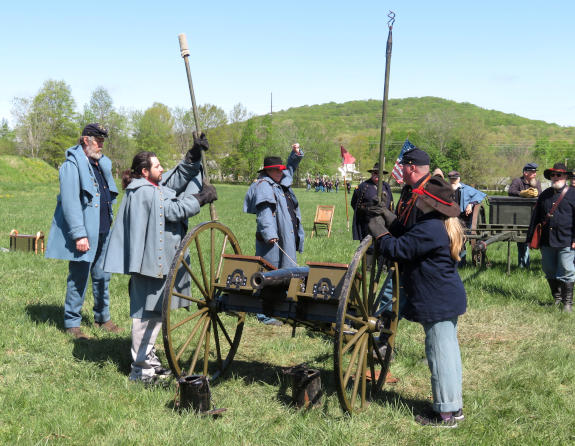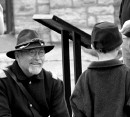THIS IS GOOD, BUT DID THEY REALLY ALL HAVE ENGLISH ACCENTS?
An American Civil War Reenactment in England, reported from an American Perspective.
by Bill Baehr
Drums beat, muskets fired, and the Rebs couldn’t retreat because of the Foot and Mouth restrictions. So, instead they attack and outflank their Union foes. Wait…Foot and Mouth restrictions? That’s right. This is an American Civil War reenactment in the United Kingdom. This summer I had the opportunity to attend one on a European vacation. I was surprised.
It was touted as the largest reenactment in England this year. Weston Park, a large park with Victorian structures, would host the American Civil War Society’s reenactment of 2nd Manassas. Our family was all set to go two months before the event; we had Mr. Lawrence Hatter (a new member of the Turner Brigade from England) set us up with units “over there”. But then it was still subject to cancellation due to Foot and Mouth disease. This is a fact which kept many of the “continentals”, reenactors from France, Belgium, and Germany, from attending.
I arrived Friday evening and located my unit. I was hosted by the 18th Missouri Infantry and the rest of the Union contingent from the Southern Skirmish Association (SoSkAn, the other large American Civil War society in England). My parents and brother, who arrived Saturday, were hosted by Battery B of the 2nd U.S. Artillery, ACWS.
The first thing I noticed about English reenactments was the hospitality. The first man I ran into was the commander of the Federal forces for that weekend, who took me to his tent and offered me a beverage and something to eat, and then helped me to find my outfit. The boys in the 18th did their darndest to make me feel comfortable.
The second thing I noticed about English reenactments was the fact that they don’t allow ground fires, so all the units had box stoves that looked like park barbeque grills except they sat about ten centimeters above the ground.
The next day, I paid my fee, collected my shotgun and black powder permits (required by British law), and began my day. Soon all the men of both sides gathered in a field and formed an inverted square for morning announcements. Then all the Union soldiers marched down to the battlefield where the commander walked us through the whole battle, and how we would fight it.
Following being thoroughly bored, it was time to roll rounds. That’s right, at ACWS reenactments, reenactors are not allowed to bring rounds onto the site; they have to be made there. So, with much complaining from my SoSkAn brethren, we had a giant round rolling party in the company wall tent. Then it was time for lunch. Food was standard reenactor fare, except the bacon looked a little weird.
Then came the highlight of the reenactment, the battle. This was only like reenactments in Missouri in the fact there were two sides and they were in opposition. Maybe a third of the men (and I use that term loosely) in our unit were “non-firers”, which means that they had deactivated guns, which could only fire caps. The cute private beside me had one of these. She died about halfway through the battle. There were as many women in the ranks as at eastern U.S. events.
There were about a thousand reenactors at the event, evenly distributed between Union and Confederate. There were six Federal guns and maybe four Rebel. Twelve Confederate cavalry were the only horses at the event, and they were galvanized Federals. The Union forces attacked a “stone wall” (in fact a barbed wire fence with burlap over it) and were repulsed. Then the Rebels poured from behind the wall and slammed into our left flank.
All this time pyrotechnics were going off, and men were dying. By men were dying, I mean Union soldiers were dying. My company fired two good volleys into the flank of a Rebel unit not twenty meters away, and not one man fell, they just smiled. Pyro-men were yelling, “Mind the wires!” and the Confederates came on. They broke scenario and slammed into us. Hand to hand ensued, and I was killed (hardly the way to treat a guest). The battle was over soon afterwards, and everyone formed up to pass in review, while the announcer told the spectators which units participated. Then the men broke ranks and policed up all the paper cartridges.
The rest of the day was free. The rest of my family had arrived during the battle, and the day was used getting them acclimated to the camp. After dinner and more down time, it was time for the dance. You know, it’s really funny to see two or three hundred reenactors dressed up in period costume standing in a courtyard between several period buildings, and listening to a country western band with electric guitars and amplifiers. There was beer, soda, coffee, and some food, and very little dancing. That’s not a dance. That’s a concert. Oh well, different strokes and all that.
The next day was almost a repeat of the first. The entire military body of reenactors was addressed in the same way, we had enough rounds, so instead we drilled, and the battle was almost a repeat of the second day, except I died sooner, and the Confederates were armed with paper mache stones, as were Stonewall Jackson’s men. (Second Manassas saw a giant influx of paper cuts in Union field hospitals.) The event broke up around five in the afternoon.
I must say that this event was an eye opener for me. They do so many things differently in England. They fed me and provided me with a bed and a musket, and wouldn’t let me clean it. (I did manage to have them let me do the dishes for them, though.) Some things disappointed me though. I don’t know about other British units, but mine had to be taught oblique movements, by the right and left flanks, and “on the right by files into line.” This was not impressive. Neither was the reviewing the battles in the morning, or the having to roll rounds before the battles. Overall, however, it was a good event, and I would definitely do it again if I ever got the chance. It is kind of funny to hear Rebels with an English accent though.
This article was originally published in the September 2001 issue of The Shrapnel, the newsletter of the Turner Brigade. For information about The Shrapnel, contact Sheila Porter, Editor.



